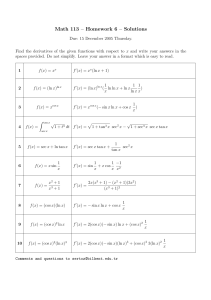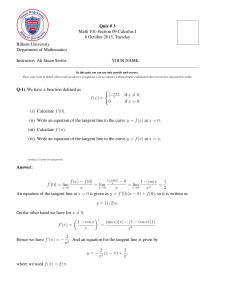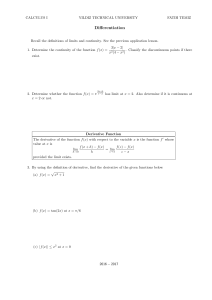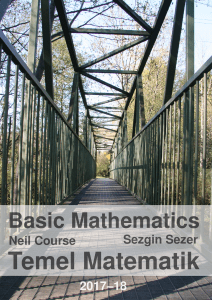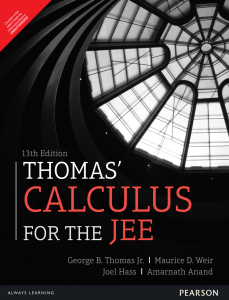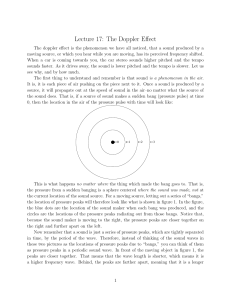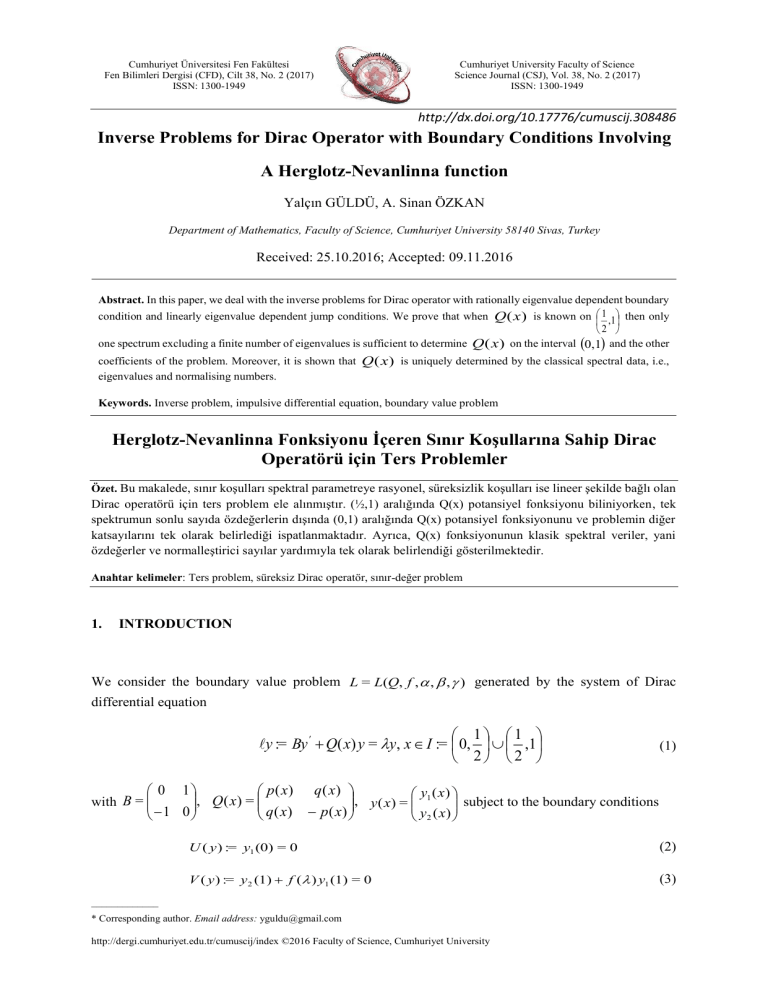
Cumhuriyet Üniversitesi Fen Fakültesi
Fen Bilimleri Dergisi (CFD), Cilt 38, No. 2 (2017)
ISSN: 1300-1949
Cumhuriyet University Faculty of Science
Science Journal (CSJ), Vol. 38, No. 2 (2017)
ISSN: 1300-1949
http://dx.doi.org/10.17776/cumuscij.308486
Inverse Problems for Dirac Operator with Boundary Conditions Involving
A Herglotz-Nevanlinna function
Yalçın GÜLDÜ, A. Sinan ÖZKAN
Department of Mathematics, Faculty of Science, Cumhuriyet University 58140 Sivas, Turkey
Received: 25.10.2016; Accepted: 09.11.2016
Abstract. In this paper, we deal with the inverse problems for Dirac operator with rationally eigenvalue dependent boundary
condition and linearly eigenvalue dependent jump conditions. We prove that when Q (x ) is known on 1 ,1 then only
2
one spectrum excluding a finite number of eigenvalues is sufficient to determine Q (x ) on the interval 0,1 and the other
coefficients of the problem. Moreover, it is shown that Q (x ) is uniquely determined by the classical spectral data, i.e.,
eigenvalues and normalising numbers.
Keywords. Inverse problem, impulsive differential equation, boundary value problem
Herglotz-Nevanlinna Fonksiyonu İçeren Sınır Koşullarına Sahip Dirac
Operatörü için Ters Problemler
Özet. Bu makalede, sınır koşulları spektral parametreye rasyonel, süreksizlik koşulları ise lineer şekilde bağlı olan
Dirac operatörü için ters problem ele alınmıştır. (½,1) aralığında Q(x) potansiyel fonksiyonu biliniyorken, tek
spektrumun sonlu sayıda özdeğerlerin dışında (0,1) aralığında Q(x) potansiyel fonksiyonunu ve problemin diğer
katsayılarını tek olarak belirlediği ispatlanmaktadır. Ayrıca, Q(x) fonksiyonunun klasik spektral veriler, yani
özdeğerler ve normalleştirici sayılar yardımıyla tek olarak belirlendiği gösterilmektedir.
Anahtar kelimeler: Ters problem, süreksiz Dirac operatör, sınır-değer problem
1.
INTRODUCTION
We consider the boundary value problem L = L(Q, f , , , ) generated by the system of Dirac
differential equation
1 1
y := By ' Q( x) y = y, x I := 0, ,1
2 2
(1)
p( x) q( x)
0 1
y ( x)
, y ( x) = 1 subject to the boundary conditions
, Q ( x) =
q( x) p( x)
1 0
y2 ( x)
with B =
U ( y ) := y1 (0) = 0
(2)
V ( y ) := y 2 (1) f ( ) y1 (1) = 0
(3)
_____________
* Corresponding author. Email address: [email protected]
http://dergi.cumhuriyet.edu.tr/cumuscij/index ©2016 Faculty of Science, Cumhuriyet University
GULDU, OZKAN
and the jump conditions
1
1
y1 ( 0) = y1 ( 0)
2
2
1
1
1
y 2 ( 0) = 1 y 2 ( 0) ( ) y1 ( 0).
2
2
2
(4)
Here p(x) and q(x) are real valued functions in L2 (0,1) ; is a spectral parameter;
, and
are real numbers, > 0 , > 0 ; f ( ) is a rational function of Herglotz–Nevanlinna type such that
N
fk
k =1 g k
f ( ) = a b
where a, b,
f k , gk
are real numbers, a > 0,
f k > 0, g1 < g2 < ... < g N .
We shall note that if
f ( ) = then the condition (3) will be as the condition y1 (1) = 0 .
Inverse problems for Dirac operator have been rather well studied and continued acceleratingly(see [14],
[15], [18], [24] and references therein)
When the spectrum of a differential operator and the potential on a half of the interval are known, one
can recover the differential operator on whole interval. Such problems are known as half-inverse
problems. The first study on the half-inverse problem for Sturm-Liouville operator was made by
Hochstadt and Lieberman in 1978 [21]. They proved that if the potential function q x of Sturm-
1
2
Liouville equation is given over the interval ,1 , then one spectrum is enough to determine q x on
the interval 0,
1
. After that in 1984, Hald [20] showed that if the potential is known over half the
2
interval and if one boundary condition is given, then the eigenvalues uniquely determine the potential
and the other boundary condition. In 1994, T. N. Arutyunyan [3] proved that the potential Q (x ) is
uniquely determined by the eigenvalues and normalising coefficients. Later, in [16] and in [25], it is
provided some results in inverse spectral analysis with partial data on the potential.
Spectral problems involving eigenvalue dependent boundary conditions arise in various problems of
mathematics as well as in applications. Firstly, in 1973, Walter [36] was interested in an expansion
theorem for the this kind of eigenvalue problem. In 1977, Fulton [13] also examined the Sturm-Liouville
eigenvalue problem. Inverse problems for some classes of differential operators linearly eigenvalue
dependent are analysed in diverse papers (see [1, 2, 9, 17, 22]). More general boundary conditions are
observed in [4-6, 10, 12, 26, 29, 30, 34,35]. On the other hand, when f ( ) is a rational function of
Herglotz–Nevanlinna type, direct and inverse spectral problems for Sturm-Liouville operator were
investigated in [7, 8, 27].
Recently, also some new uniqueness results in inverse spectral analysis with partial information on the
potential for Sturm-Liouville and Dirac operator have been given (see , [28, 31-33]).
In the present paper, our research is connected to a Dirac equation with rationally eigenvalue dependent
boundary conditions and linearly eigenvalue dependent jump conditions. We prove that the potential in
205
Inverse Problems for Dirac Operator with Boundary
(0,1) and the remaining coefficients of the boundary value problem can be uniquely determined by the
1
potential in ( ,1) and one spectrum excluding finite eigenvalues. We also show that Q (x ) is uniquely
2
determined by the sequences of eigenvalues and normalising numbers.
2.
PRELIMINARIES
Firstly, we define an operator such that (1)-(4) can be regarded as an eigenvalue problem of it. See [8]
and [27] for a similar operator associated with the Sturm- Liouville problem.
Consider the space
H = L2 (0,1) L2 (0,1) CN 2
with the inner product defined by
Y Z
y ( x) z ( x) y ( x) z ( x)dx f
1
Y , Z :=
N
1
1
2
k
2
k =1
0
where
k
k
YN 1 Z N 1 YN 2 Z N 2
a
Y = y1 ( x), y2 ( x), Y1, Y2 ,...YN 2 , Z = z1 ( x), z2 ( x), Z1 , Z 2 ,...Z N 2 .
(5)
Define the operator T
with the domain
D(T ) = {Y H :
y1 (0) = 0, y1 (
y1 ( x)
and y 2 ( x ) are absolutely continuous in I , y L2 (0,1),
1
1
0) y1 ( 0) = 0,
2
2
YN 1 = ay1 (1),
1
YN 2 = y1 ( 0)} such that
2
T Y = Z = z1 ( x), z2 ( x), Z1, Z 2 ,...Z N 2 ,
z ( x)
where z ( x) = 1 = y ( x) ,
z 2 ( x)
Z i = g iYi f i y1 (1), for i = 1, N
N
Z N 1 = y2 (1) by1 (1) Yk
k =1
and
1
1
1
Z N 2 = y2 ( 0) 1 y1 ( 0) y1 ( 0)
2
2
2
Theorem 1 Eigenvalues of the operator T coincide with eigenvalues of the problem L .
206
GULDU, OZKAN
Proof. The following equalities obtained from TY = Y are enough to see validity of this
theorem:
g1Y1 b1 y1 (1) = Y1
g 2Y2 b2 y1 (1) = Y2
...
g NY1 bN y1 (1) = YN
N
y2 (1) by1 (1) Yk = ay1 (1)
k =1
1
1
1
1
y2 ( 0) 1 y2 ( 0) y1 ( 0) = y1 ( 0).
2
2
2
2
Let the function
( x, ) = 1 ( x, ) 2 ( x, )
T
be the solution of (1) under the initial
conditions
0
(0, ) =
1
and under the jump conditions (4). ( x, ) satisfies the following integral equations:
For x <
1
2
x
x
0
0
1 ( x, ) = sin x sin ( x t ) (t , )dt cos ( x t ) (t , )dt
x
x
0
0
2 ( x, ) = cos x cos ( x t ) (t , )dt sin ( x t ) (t , )dt
and for x >
1
2
1 ( x, ) = sin x sin (1 x)
1/2
sin ( x t ) sin (1 x t ) (t , )dt
cos ( x t ) cos (1 x t ) (t , )dt
0
1/2
0
207
(6)
Inverse Problems for Dirac Operator with Boundary
sin ( x t )
x
(t , ) cos ( x t ) (t , ) dt
1/2
( )
cos x cos (1 x) [cos ( x t ) cos (1 x t )] (t , )dt
2
0
1/2
1/2
[sin ( x t ) sin (1 x t )] (t , )dt
0
2 ( x, ) = cos x cos (1 x)
1/2
cos ( x t ) cos (1 x t ) (t , )dt
sin ( x t ) sin (1 x t ) (t , )dt
0
1/2
0
cos ( x t )
x
(t , ) sin ( x t ) (t , ) dt
1/2
( )
sin x sin (1 x) [sin ( x t ) sin (1 x t )] (t , )dt
2
0
1/2
1/2
[cos ( x t ) cos (1 x t )] (t , )dt
0
where
(t, ) = 1 (t, ) p(t ) 2 (t, )q(t ), (t, ) = 1 (t, )q(t ) 2 (t, ) p(t )
and
1
1
= .
2
Moreover, it is shown in [14] that, ( x, ) has a representation as follows:
x
1
2
( x, ) = 0 ( x, ) K ( x, t ) 0 (t , )dt , for x 0,
0
where
0 ( x, ) = sin x cos x , K ( x, t ) = Kij ( x, t )i , j =1,2
T
Kij x,. L2 (0,1) for each fixed x.
The following asymptotic relations can be proved easily;
208
(7)
GULDU, OZKAN
sin x o(exp x ),
1 ( x, ) =
cos x cos (1 x) o( exp x ),
2
cos x o(exp x),
2 ( x, ) =
sin x sin (1 x) o( exp x),
2
1
2
1
x>
2
x<
1
2
1
x>
2
x<
where = Im .
It is clear that f ( ) can be written as follows:
a ( )
b ( )
f ( ) =
where
a ( ) = a b g k f k g j ,
N
N
N
k =1
k =1
j =1
j k
N
b( ) = g k .
k =1
Let the function
( x, ) = 1 ( x, ) 2 ( x, )
T
be the solution of (1) under the initial
conditions
b ( )
a ( )
(1, ) =
(8)
and under the jump conditions (4).
Consider the function
( ) := W , = 2 ( x, ) 1 ( x, ) 1 ( x, ) 2 ( x, )
(9)
= a ( )1 (1, ) b( ) 2 (1, ) = 1 (0, ).
It is obvious that ( ) is entire function and the zeros, namely
the problem (1)-(4). Additionally, the equality
n = 2 (0, n ) =
n nZ of ( ) are eigenvalues of
( x, n ) = n ( x, )
b ( n )
.
1 (1, n )
209
holds for all
x
and , where
Inverse Problems for Dirac Operator with Boundary
3.
UNIQUENESS THEOREMS
3.1 According to the mixed given data
The first main result of this work is a generalized of Hochstadt and Lieberman theorem [21]. We prove
1
2
that when Q (x) is known on ,1 then only one spectrum excluding a finite number of eigenvalues
is sufficient to determine Q (x ) on the interval 0,1 and the coefficients , and . Together with
~
L , we consider the problem L
of the same form but with a different coefficients
~p ( x) q ( x) ~ ~
~
~
Q ( x) =
~ , , and . It is assumed in what follows that if a certain symbol s
q ( x) p ( x)
s with tilde denote the analogous object
denotes an object related to L , then the corresponding symbol ~
~
related to L . Let us denote by
Let
Z0
( x, n ),
the eigenfunction which corresponds to
n .
be any subset with N 1 elements of Z. Denote := n nZ \ Z and consider the
0
following representation:
( ) = R ( ) n
nZ 0
where R ( ) = C 1 , C is a constant which depends only on
n
n
requires minor modifications).
Theorem 2 If = ~ ,
2
~
=
and = ~ .
Before the proof of theorem, we need to prove the following lemma.
Lemma 1 i) The eigenvalues
d( )
0 , i.e.,
d =
(the case (0) = 0
~
~
~
1
f ( ) f ( ) and Q( x) = Q ( x) on ,1 then Q( x) = Q ( x)
almost everywhere on 0,1 , = ~ and
ii)
n
n
are real numbers.
n nZ are simple zeros of ( ) .
n
210
GULDU, OZKAN
Proof. i) According to the Theorem 1, it is enough to show that eigenvalues of T are real. For
Y in D(T ), we calculate that
TYk Y k TYN 1Y N 1 TYN 2 Y N 2
fk
a
k =1
1
N
TY , Y = y ( x) y ( x)dx
0
1
1
= p( x) y1 ( x) y2 ( x) dx 2 Re y2 ( x) y1 ( x)q( x)dx
2
2
0
0
1 1
1 1
y1 0 y2 0 y1 0 y2 0 y1 0 y2 0
2 2
2 2
1
N
g kYk f k y1 (1)Y k
0
k =1
fk
y1 1 y2 1 2 Re y2 ( x) y1 ( x)dx
N
y2 (1) by1 (1) Yk y1 (1)
k =1
1
1
1
1
y2 ( 0) 1 y2 ( 0) y1 ( 0) y1 ( 0).
2
2
2
2
By using the structure of T , we obtain
1
1
TY , Y = p( x) y1 ( x) y2 ( x) dx 2 Re y2 ( x) y1 ( x)q( x)dx
2
2
0
0
1
N
0
k =1
2 Re y2 ( x) y1 ( x)dx
N
gk
2
Yk 2 Re y1 (1)Y k
fk
k =1
2
1
b y1 1 y1 ( 0) .
2
2
We conclude that TY, Y are real for each Y in D(T ) . Thus, all eigenvalues of the operator T (or
problem L ) are real numbers.
ii) Assume
n g k . If n = gk ,
Write the equation (1) for
the proof is similar.
x, n and x, respectively.
2' ( x, n ) p x 1 x, n qx 2 x, n = n1 x, n ,
'
1 ( x, n ) q x 1 x, n p x 2 x, n = n 2 x, n
211
Inverse Problems for Dirac Operator with Boundary
2' ( x, ) px 1 x, q x 2 x, = 1 x, ,
'
1 ( x, ) qx 1 x, p x 2 x, = 2 x, .
After some operations, we obtain
1 ( x, n ) 2 ( x, ) 2 ( x, n ) 1 ( x, )
1
2
0
1
1
2
1
= ( n ) 1 ( x, )1 ( x, n ) 2 ( x, ) 2 ( x, n )dx.
0
Take into account of boundary and discontinuity conditions to get
1 (0, ) a( )1 (1, n ) b 2 (1, n )
1 ( 1 0, n ) 2 ( 1 0, ) 2 ( 1 0, n ) 1 ( 1 0, )
2
2
2
2
1 ( 1 0, n ) 2 ( 1 0, ) 2 ( 1 0, n ) 1 ( 1 0, )
2
2
2
2
1
= ( n ) 1 ( x, )1 ( x, n ) 2 ( x, ) 2 ( x, n )dx.
0
Using (4) and (9) we get
1
b 1 (1, n ) f f n ( n )1 ( 0, n ) 1 ( 1 0, )
2
2
1
= ( n ) 1 ( x, )1 ( x, n ) 2 ( x, ) 2 ( x, n )dx.
0
If we divide both side of this equality by
( n )
and take limit for
n ,
1 2
1
n 1 ( x, n ) 22 ( x, n ) dx 12 (1, n ) f n 12 ( 0, n ) = (n ) .
2
0
Since > 0, > 0 and f n > 0 for all
Let us write the equation (1) for
n ,
~,
and
B ( x, ) Q( x) ( x, ) = ( x, )
212
(n ) 0.
GULDU, OZKAN
~
B~ ( x, ) Q( x)~( x, ) = ~( x, )
Multiply these equalities by
~ T ( x, ) and T ( x, ) respectively from left hand side and subtract then
we get
d
1 ( x, )~2 ( x, ) ~1 ( x, ) 2 ( x, )
dx
~
= Q( x) Q ( x) ( x, )~ ( x, ).
(10)
After integrating this equality on 0,1, taking into account the hypothesis
~
1
Q( x) = Q ( x) on ,1 , we find
2
1 ( x, )~2 ( x, ) ~1 ( x, ) 2 ( x, ) 1/2
0 1/2
1
1
2
= p ( x ) ~
p ( x) ~ ( x, ) T J , ( x, ) dx
(11)
0
1 0
. Denote
0 1
where .,. denotes the classical inner product of C2 and J :=
~ (1, ) (1, )
~ (1, ).
H ( ) := 2 (1, )
1
1
2
(12)
One can calculate from (4) and (11) that
1
2
2 (1, )~1 (1, ) 1 (1, )~2 (1, ) = p( x) ~
p ( x) ~ ( x, ) T J , ( x, ) dx (13)
0
1
1
1
~ 1
1 ~ 1 ( 0, )~2 ( 0, ) 1 2 ( 0, )~1 ( 0, )
2
2
2
2
1
1
~
~ ~ ~ 1 ( 0, )~1 ( 0, ).
2
2
It is obtained from
~
f ( ) f ( ) that 2 (1, n )~1 (1, n ) 1 (1, n )~2 (1, n ) = 0 . Therefore,
H (n ) = 0 for all n .
Now, define F ( ) :=
H ( )
which is an entire function on . From asymptotic relations of
R ( )
1
. Therefore, from Liouville’s Theorem,
1 ( x, ) and 2 ( x, ) , it is valid that F ( ) = O
213
Inverse Problems for Dirac Operator with Boundary
F ( ) 0
and
1
2
p ( x ) p ( x ) ( x , )
~
~
H ( ) 0.
so
T
J , ( x, ) dx =
0
One
can
calculate
that
1
2
1
p( x) ~p ( x)dx o1, for , R . Therefore
2 0
it can be written the following equality from (13),
1 ~
1 ~
~
~ ~ 1 cos o1 ~ sin o1
2
2
1
2
1
p( x) ~p ( x)dx = o1 for , R.
20
We obtain from the last relation that,
1
2
~
= = ~ = and so,
~ ~
= ~, = ~,
~
= ,
p( x) p ( x)dx = 0. As a consequent,
~
0
1
2
p ( x ) p ( x ) ( x, )
~
~
T
J , ( x, ) dx = 0 holds on the whole -plane.
0
On the other hand, the following equality is valid,
x
x
0
0
~( x, ) T J , ( x, ) = cos 2x K 1 ( x, t ) cos 2tdt K 2 ( x, t ) sin 2tdt
where
Ki ( x, t ),
x
i = 1,2, depend only on
and
t. It follows from (13) that
1
2
x
x
0 P( x)cos 2x 0 K1 ( x, t ) cos 2tdt 0 K 2 ( x, t ) sin 2tdtdx = 0
(14)
for all , where P ( x) := p ( x) ~
p ( x ). This can be rewritten as
1
2
0 cos 2 P( ) P( x) K1 ( x, t )dx dt
1
2
1
2
1
2
0
sin 2t P ( x ) K 2 ( x, t ) dxdt = 0
214
(15)
GULDU, OZKAN
Therefore, we obtain from the completeness of the vector functions
cos 2
sin 2t in
T
1
1
1
p ( x) for x (0, ) . This completes the proof.
L2 (0, ) L2 (0, ) that P(x) = 0 , i.e. p( x) = ~
2
2
2
3.2 According to the classical spectral data
In [23], it is proven that the coefficients of the problem L are uniquely determined by the Weyl
function. We aim to prove uniqueness of the coefficients according to the eigenvalues and normalising
~
q~ ( x )
~ .
q ( x) p ( x)
p ( x)
~
~
numbers, namely spectral data. Consider the problem L with the coefficient Q ( x ) = ~
For an element
Y = y1 ( x), y2 ( x), Y1, Y2 ,...YN 2
in H , the norm of Y
is defined by
2
Y := Y , Y . From (5), we get
1
N
Y = y1 ( x) y2 ( x) dx
2
2
2
k =1
0
Let
n
Yk
fk
2
YN 1
a
2
Y
N 2
2
be an eigenvalue of T (or the problem L ) and Y (n) eigenvector for
numbers n := Y (n)
2
(16)
n . Then the
are called as normalizing numbers.
Lemma 2 The equality
n = 12 ( x, n ) 22 ( x, n )dx
1
0
f ' (n )12 (1, n ) 12 (d1 0, n )
is valid.
Proof. Let
n g k .
Since
n = g k
is equivalent to
1 1, gk = 0 ,
this case requires minor
modification in the following proof.
Using the structure of T and the inner product in (5), a direct calculation yields
1
Y (n) = 12 ( x, n ) 22 ( x, n ) dx
2
0
N
k =1
Yk
fk
2
YN 1
a
2
YN 2
2
215
Inverse Problems for Dirac Operator with Boundary
1
= 12 ( x, n ) 22 ( x, n ) dx
0
N
fk
a12 (1, n )
2
k =1 g k n
12 (1, n )
1
= 12 ( x, n ) 22 ( x, n ) dx
0
N
fk
1
12 (1, n )a
12 ( 0, n )
2
2
k =1 g k n
1
1
= 12 ( x, n ) 22 ( x, n ) dx f ' (n )12 (1, n ) 12 ( 0, n )
2
0
Take into account Lemma 1 and Lemma 2 to get the following relation
' ( n ) = n n
(17)
The Weyl function is defined as follows;
m ( ) =
~ ( ) then
Theorem 3 [23] If m( ) = m
2 (0, )
.
( )
(18)
~
L = L ; i.e. the Weyl function
m( ) determines
uniquely the problem L .
Theorem 4 If
n , n = ~n , ~n then L = L~; i.e. the spectral data n , n determine
uniquely the problem L .
Proof.
Since
~
n = n ,
~
( ) = ( ).
Therefore,
from
(17)
n = ~n
so
2 (0, n ) = ~2 (0, n ). Hence the function defined as
G ( ) :=
2 (0, ) ~2 (0, )
( )
is an entire on . Moreover, one can obtained that G( ) = o(1) for
.
G ( ) 0 and so
~
~ ( ) . Consequently, from Theorem 3, L = L
.
2 (0, ) ~2 (0, ). From (18) we have m( ) = m
216
GULDU, OZKAN
REFERENCES
[1].
[2].
[3].
[4].
[5].
[6].
[7].
[8].
[9].
[10].
[11].
[12].
[13].
[14].
[15].
[16].
[17].
[18].
R.Kh. Amirov, A.S. Ozkan and B. Keskin, Inverse problems for impulsive Sturm-Liouville
operator with spectral parameter linearly contained in boundary conditions, Integral Transforms
and Special Functions, 20(8)(2009), 607-618.
R. Kh. Amirov, B. Keskin, A. S. Ozkan, Direct and inverse problems for the Dirac operator with
spectral parameter linearly contained in boundary condition, Ukrainian Math. J., 61(91)(2009),
1155–1166.
T. N. Arutyunyan, Isospectral Dirac operators, Izv. Nats. Akad. Nauk Armenii Mat. 29(2)(1994),
3–14, ; English transl. in J. Contemp. Math. Anal., Armen. Acad. Sci. 29(2)(1994), 1-10.
P.A. Binding, P.J. Browne and K. Seddighi, Sturm–Liouville problems with eigenparameter
dependent boundary conditions, Proc. Edinburgh Math. Soc., 37(2)(1993), 57-72.
P.A. Binding, P.J. Browne and B.A. Watson, Inverse spectral problems for Sturm–Liouville
equations with eigenparameter dependent boundary conditions, J. London Math. Soc., 62(2000),
161-182.
P.A. Binding, P.J. Browne and B.A. Watson,. Equivalence of inverse Sturm–Liouville problems
with boundary conditions rationally dependent on the eigenparameter, J. Math. Anal. Appl.,
291(2004), 246-261.
P.A. Binding, P.J. Browne, B.A. Watson, Sturm–Liouville problems with boundary conditions
rationally dependent on the eigenparameter, I, Proc.Edinburgh Math.Soc., 45(2002), 631–645.
P.A. Binding, P.J. Browne, B.A. Watson, Sturm–Liouville problems with boundary conditions
rationally dependent on the eigenparameter, II, Journal of Computational and Applied
Mathematics, 148(2002), 147-168.
P.J. Browne and B.D. Sleeman, A uniqueness theorem for inverse eigenparameter dependent
Sturm-Liouville problems, Inverse Problems, 13(1997), 1453-1462.
Chernozhukova and G. Freiling, A uniqueness theorem for the boundary value problems with
non-linear dependence on the spectral parameter in the boundary conditions, Inverse Problems in
Science and Engineering, 17(6)(2009), 777-785.
G. Freiling and V.A. Yurko, Inverse Sturm–Liouville problems and their applications, Nova
Science, New York, 2001.
G. Freiling and V.A. Yurko, Inverse problems for Sturm–Liouville equations with boundary
conditions polynomially dependent on the spectral parameter, Inverse Problems, 26(2010)
055003 (17pp.).
C.T. Fulton, Two-point boundary value problems with eigenvalue parameter contained in the
boundary conditions, Proc. R. Soc. Edinburgh, A77(1977), 293-308.
M. G. Gasymov, Inverse problem of the scattering theory for Dirac system of order 2n, Tr. Mosk
Mat. Obshch., 19(1968), 41-112, Birkhauser, Basel, (1997).
M. G. Gasymov and T. T. Dzhabiev, Determination of a system of Dirac differential equations
using two spectra, Proceeding of School-Seminar on the Spectral Theory of Operators and
Representations of Group Theory [in Russian], Elm, Baku, (1975), 46-71.
F. Gesztesy and B. Simon . Inverse spectral analysis with partial information on the potential II:
The case of discrete spectrum. Trans. Amer. Math. Soc. 352(6)(2000), 2765–2787.
N.J. Guliyev, Inverse eigenvalue problems for Sturm-Liouville equations with spectral parameter
linearly contained in one of the boundary condition, Inverse Problems, 21(2005), 1315-1330.
M. Guseinov, On the representation of Jost solutions of a system of Dirac differential equations
with discontinuous coefficients, Izv. Akad. Nauk Azerb. SSR, 5(1999), 41-45.
217
Inverse Problems for Dirac Operator with Boundary
[19]. Y. Güldü, A Half-Inverse Problem for Impulsive Dirac Operator with Discontinuous Coefficient,
Abstract and Applied Analysis, Volume 2013, Article ID 181809.
[20]. O.H. Hald, Discontiuous inverse eigenvalue problems, Comm. Pure Appl. Math., 37(1984), 539577.
[21]. H. Hochstadt and B. Lieberman, An inverse Sturm-Liouville problem with mixed given data,
SIAM J. Appl. Math. 34(1978), 676–680.
[22]. B. Keskin and A.S. Ozkan, Inverse spectral problems for Dirac operator with eigenvalue
dependent boundary and jump conditions, Acta Math. Hungar., 130(4)(2011), 309-320.
[23]. B. Keskin, Inverse spectral problems for impulsive Dirac operators with spectral parameters
contained in the boundary and discontinuity conditions polynomially, Neural Computing and
Applications, 23(5)(2013), 1329-1333.
[24]. B.M. Levitan, and I. S. Sargsyan, Sturm-Liouville and Dirac operators [in Russian], Nauka,
Moscow, 1988.
[25]. M.M. Malamud, Uniqueness questions in inverse problems for systems of differential equations
on a finite interval, Trans. Moscow Math. Soc. 60(1999), 204–262.
[26]. R. Mennicken, H. Schmid and A.A. Shkalikov, On the eigenvalue accumulation of SturmLiouville problems depending nonlinearly on the spectral parameter, Math. Nachr., 189(1998),
157-170.
[27]. A.S. Ozkan, Half-inverse Sturm-Liouville problem with boundary and discontinuity conditions
dependent on the spectral parameter, Inverse Problems in Science and Engineering 22(5)(2014),
848-859.
[28]. L. Sakhnovich, Half inverse problems on the finite interval. Inverse Problems 17(2001), 527–532.
[29]. H. Schmid and C. Tretter, Singular Dirac systems and Sturm–Liouville problems nonlinear in the
spectral parameter, Journal of Differential Equations, 181(2)(2002), 511-542.
[30]. A.A. Shkalikov, Boundary value problems for ordinary differential equations with a parameter in
the boundary conditions. J. Sov. Math. 33(1986), 1311-1342. Translation from Tr. Semin. Im.
I.G. Petrovskogo 9(1983), 190-229.
[31]. C-Fu Yang and Z-You Huang, A half-inverse problem with eigenparameter dependent boundary
conditions, Numerical Functional Analysis and Optimization, 31(6)(2010), 754-762.
[32]. C-Fu Yang, Hochstadt-Lieberman theorem for Dirac operator with eigenparameter dependent
boundary conditions, Nonlinear Analysis Series A: Theory, Methods and Applications, 74(2011),
2475-2484.
[33]. C-Fu Yang, Determination of Dirac operator with eigenparameter dependent boundary conditions
from interior spectral data, Inverse Problems in Science and Engineering, 20(3)(2012), 351–369.
[34]. V.A. Yurko, Boundary value problems with a parameter in the boundary conditions, Izv. Akad.
Nauk Armyan. SSR, Ser. Mat., 19(5)(1984), 398–409. English translation in Soviet J.
Contemporary Math. Anal., 19(5)(1984), 62-73.
[35]. V.A. Yurko, An inverse problem for pencils of differential operators, Mat Sbornik,191(10)
(2000), 137-158 (Russian). English translation in Sbornik Mathematics, 191(2000), 1561-1586.
[36]. J. Walter, Regular eigenvalue problems with eigenvalue parameter in the boundary conditions.
Math. Z. 133(1973), 301-312.
218

